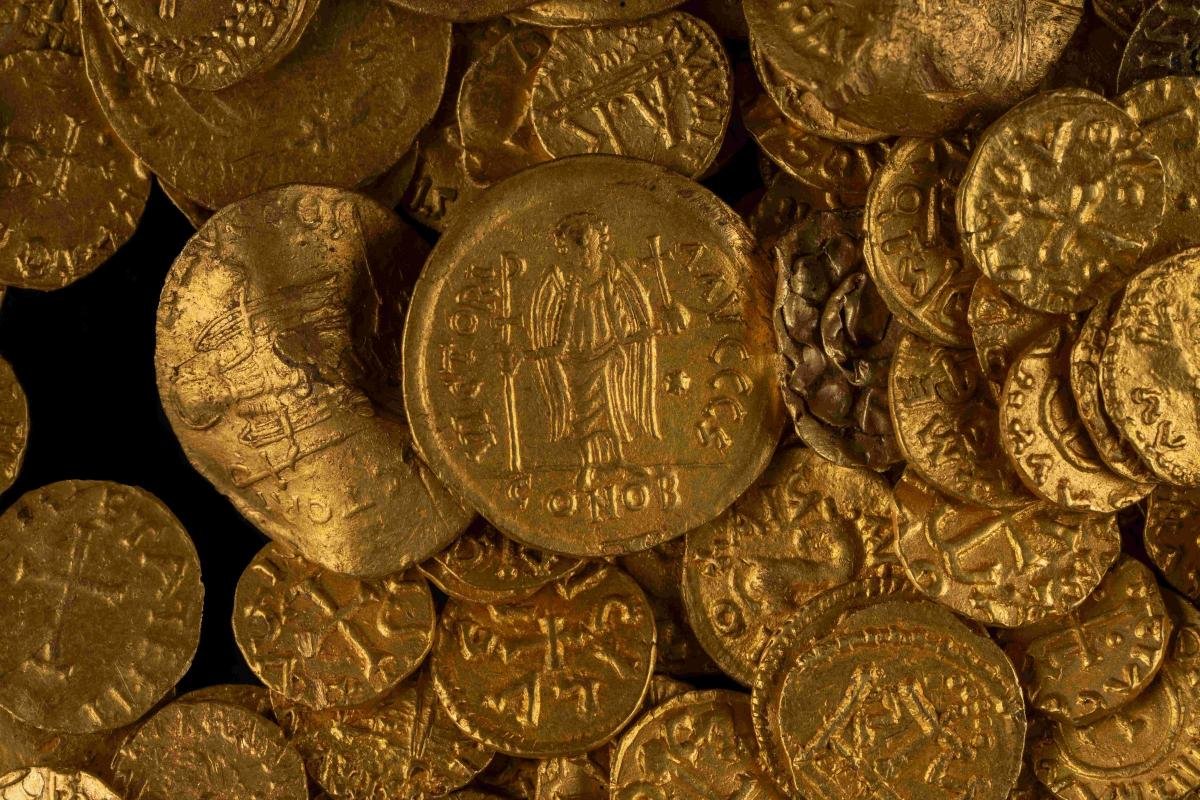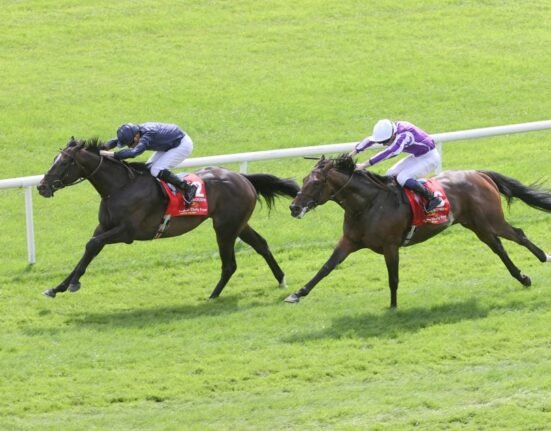They lay buried beneath the earth in a Norfolk field for 1,400 years, before the beep of a metal detector led to their discovery.
What emerged was the largest collection of seventh-century gold coins ever found in Britain, a find of international significance dubbed the West Norfolk Hoard.
Close-up of the West Norfolk Hoard, showing detail of a Byzantine gold solidus (Image: Norfolk Museums Service)
The public can now see this remarkable medieval treasure for the very first time, after Norwich Castle Museum received more than £300,000 to acquire it.
The hoard, uncovered in batches between 2014 and 2020 at an undisclosed location near King’s Lynn, contains 129 gold coins. It appears to have been buried in about 610AD, based on the date of the latest coins.
Most of them are Frankish tremisses, solid gold coins minted in the Merovingian Frankish Kingdoms that occupied much of modern-day France, Germany, Switzerland and the Low Countries.
They were the first coins made and used in Europe after the fall of the Roman empire and predate the first gold coinage made in Anglo-Saxon England.
The West Norfolk hoard is one of only eight hoards of this coin type known from Europe and only the third from the UK.
Of the 129 coins, there are 118 different coin designs and 51 different European mints represented, as well as 10 coins from Byzantium, including two from Constantinople.
The Sutton Hoo ship burial (Image: Mercie Lack/National Trust/PA Wire)
Before the West Norfolk Hoard find, the largest hoard of coins from this period was a purse containing 101 coins discovered at Crondall in Hampshire in 1828, while the famous ship burial from Sutton Hoo in Suffolk, excavated in 1939, included a purse of 37 gold coins.
The hoard, declared treasure by a coroner in 2021, has now gone on show at the newly reopened Anglo-Saxon and Viking Gallery at Norwich Castle.
Dr Tim Pestell, senior curator of archaeology at Norwich Castle (Image: Denise Bradley)
Dr Tim Pestell, senior curator of archaeology at Norwich Castle Museum and Art Gallery, said: “This internationally significant find reflects the wealth and Continental connections enjoyed by the early Kingdom of East Anglia.
“Study of the hoard and its find spot has the potential to unlock our understanding of early trade and exchange systems and the importance of west Norfolk to East Anglia’s ruling kings in the seventh century.”
The West Norfolk Hoard (Image: Norfolk Museums Service / David Kirkham)
Money from the National Heritage Memorial Fund, Art Fund, The Wolfson Foundation, the V&A Purchase Grant Fund and Friends of Norwich Museums helped Norfolk Museums Service acquire the hoard.
Simon Thurley, chairman of the National Heritage Memorial Fund, said: “Buried for over 1,400 years, the West Norfolk Hoard and the fascinating insights it offers into sixth century England’s place in the world can finally be revealed.
“We are delighted to support this acquisition which will keep the hoard intact, in the county in which it was buried and publicly accessible for everyone to enjoy.”
The West Norfolk Hoard (Image: Norfolk Museums Service. / David Kirkham)
Most of the coins were unearthed by a metal detectorist, who reported his finds to the correct authorities as the law requires.
But 10 were found by another detectorist, who sold them on the black market for £15,000 but was later caught and jailed for 16 months in 2017.
The West Norfolk Hoard now takes its place alongside other finds from the Anglo-Saxon period for which East Anglia is famed, including the renowned ship burial at Sutton Hoo.
Norwich Castle (Image: Denise Bradley)
The display of the hoard marks the reopening of Norwich Castle’s Anglo-Saxon and Viking Gallery, which was closed for several years to protect collections while work takes place to transform Norwich Castle’s Norman keep.
The reopening date for the keep itself has yet to be confirmed, but museum bosses have said they hope it will be in time for the school summer holidays.







